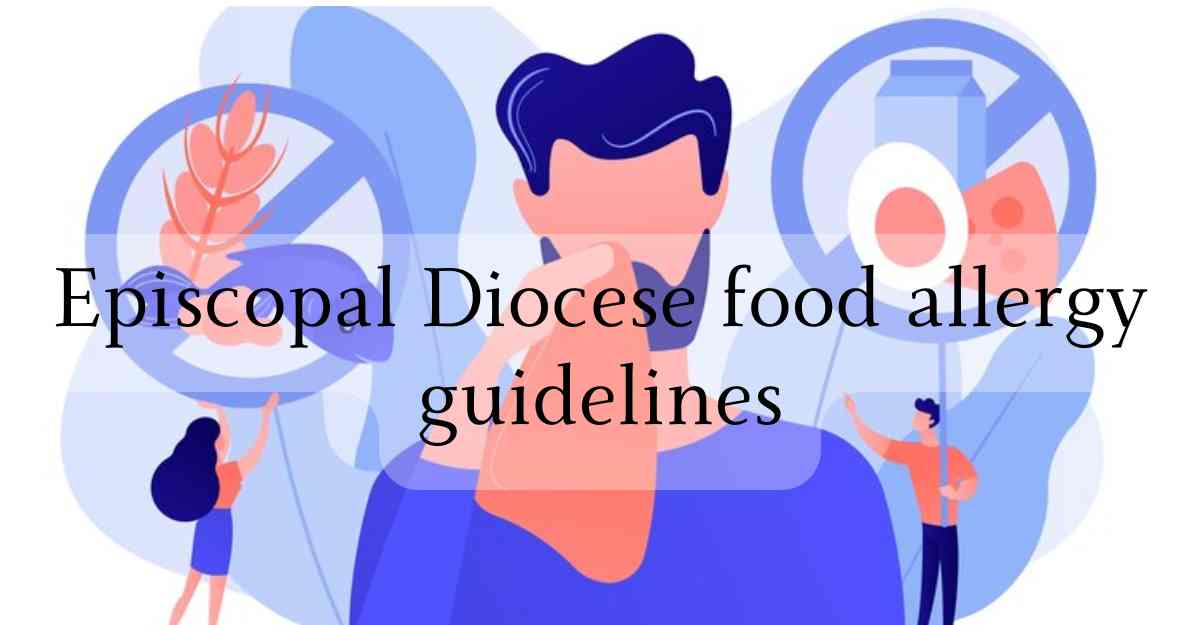Food allergies are a growing concern today, affecting millions worldwide. Within the Episcopal Diocese Food Allergy Guidelines, creating a safe and inclusive environment for all members, including those with food allergies, is crucial. This blog will delve into the Episcopal Diocese food allergy guidelines, providing comprehensive information on managing and accommodating food allergies effectively. By following these guidelines, churches and organizations within the Diocese can foster a welcoming atmosphere where everyone can participate fully and safely.
Understanding Food Allergies
What Are Food Allergies?
Food allergies are an abnormal response by the body’s immune system to certain foods. Usually, the immune system helps protect the body from harmful substances, like bacteria and viruses. However, in the case of food allergies, immune system mistakenly identifies harmless food proteins as a threat and reacts against them. This immune response triggers various symptoms, ranging from mild to severe.
How Food Allergies Develop?
Food allergies often develop at any age but are most found in children. Exact cause of food allergies are not fully understood. Still, they are thought to arise from genetic and environmental factors. If one or both parents have allergies (not necessarily food allergies), their children are more likely to develop them.
Common Food Allergens
Several foods are commonly known to cause allergic reactions. These include:
- Peanuts
- Tree nuts (such as almonds, walnuts, cashews)
- Eggs
- Milk
- Wheat
- Soy
- Fish
- Shellfish (such as shrimp, lobster, crab).
These foods account for most allergic reactions, but people can be allergic to virtually any food.

Immune System Response
Immune system is the body’s defense mechanism against harmful substances like bacteria, viruses, and toxins. It comprises various cells and proteins that work together to identify and neutralize threats. In the case of food allergies, however, the immune system mistakenly identifies specific proteins in food as dangerous, even though they are harmless that will help us understand Episcopal Diocese Food Allergy Guidelines.
The Role of Immunoglobulin E (IgE)
The central player in the immune response to food allergens is an antibody called immunoglobulin E (IgE). Here’s how the process typically unfolds:
Sensitization Phase
When a person with a genetic predisposition to allergies is first exposed to an allergenic food, their immune system may become sensitized to it. During this phase, the immune system mistakenly identifies a specific protein in the food as harmful.
Immune system responds by producing IgE antibodies specific to that food protein. These IgE antibodies circulate in the blood and attach to the surface of particular cells, including mast cells and basophils.
Mast Cells and Basophils:
Mast cells and the basophils are white blood cells crucial in allergic reactions. They are found in various tissues throughout the body, including the skin, lungs, gastrointestinal tract, and blood.
Once sensitized, these cells have IgE antibodies bound to their surfaces, effectively “priming” them for a future encounter with the allergen.
Subsequent Exposure
When the person is exposed to the same food again, the allergenic protein binds to IgE antibodies on surface of the mast cells and basophils.
This binding triggers the mast cells and basophils to release many chemical mediators, the most notable of which is histamine what we should know for Episcopal Diocese Food Allergy Guidelines.
Chemical Mediators and Their Effects
Release of histamine and other chemical mediators like leukotrienes and prostaglandins leads to the symptoms of an allergic reaction. Here’s how these chemicals affect the body:
Histamine
- Blood vessels: Histamine causes blood vessels to dilate (expand) and become more permeable, leading to symptoms like redness, swelling, and itching. This is why hives (urticaria) and localized swelling are common in allergic reactions.
- Skin: Histamine contributes to the itchy sensation associated with allergic reactions.
- Lungs: In the respiratory system, histamine can cause muscles around airways to contract, leading to bronchoconstriction. This can result in wheezing, coughing, and difficulty breathing, symptoms often seen in anaphylaxis.
Leukotrienes and Prostaglandins
These chemical mediators further amplify the inflammatory response, contributing to the severity of symptoms. They can cause additional constriction of airways, increased mucus production, and more intense swelling and pain.
Systemic Reactions and Anaphylaxis
Sometimes, the immune system response is not localized to a specific area. Still, it becomes systemic, meaning it affects the entire body. This can lead to anaphylaxis, a severe, rapid-onset allergic reaction that is life-threatening if not treated immediately.
- Cardiovascular system: Histamine and other mediators cause quick reduce in blood pressure, which can lead to shock.
- Respiratory system: The combination of airway constriction, swelling, and mucus production can lead to respiratory failure.
- Gastrointestinal system: Abdominal pain, vomiting, and diarrhea can occur as part of the body’s systemic response to the allergen.
Regulation of the Immune Response
The immune system is usually tightly regulated to avoid such overreactions. Regulatory T cells (Tregs) and other immune mechanisms help tolerate harmless substances, including food proteins. However, in people with food allergies, this tolerance is lost, leading to the inappropriate activation of the immune response.
Genetic and Environmental Factors
The likelihood of developing food allergies is influenced by both genetic and environmental factors:
- Genetics: Individuals with a family history of allergies (atopy) are more likely to develop food allergies. Specific genes may influence how the immune system responds to allergens.
- Environmental factors: Early exposure to potential allergens, the timing of introducing certain foods, and other environmental factors like pollution or diet can also impact the development of food allergies.
Current Research
Research into food allergies continues to explore the mechanisms of immune system response, aiming to understand why certain people develop food allergies while others do not. This research is crucial for developing new treatments and interventions, such as immunotherapy, to help “retrain” the immune system to tolerate specific allergens.
In summary, the immune system’s response to food allergies is a highly orchestrated process that relates to Episcopal Diocese Food Allergy Guidelines, when triggered, leads to a range of symptoms. Understanding this process is essential for managing food allergies and developing future treatments.
Symptoms of Food Allergies
Food allergy symptoms can vary widely and affect different body parts. Common symptoms include:
- Skin reactions: Hives (urticaria), itching, eczema, and swelling, particularly of face, lips, tongue, or throat.
- Gastrointestinal symptoms: Nausea, vomiting, diarrhea, stomach pain, and cramping.
- Respiratory symptoms: include wheezing, coughing, nasal congestion, shortness of breath, and, in severe cases, anaphylaxis.
- Cardiovascular symptoms: A drop in blood pressure, dizziness, fainting, or loss of consciousness.
- Anaphylaxis: Anaphylaxis is a potentially life threatening allergic reaction that occur within minutes in exposure to the allergen.
Which help us learn about Episcopal Diocese Food Allergy Guidelines.
Symptoms of anaphylaxis include:
- Difficulty breathing due to swelling of airways
- A rapid drop in blood pressure
- Weak or rapid pulse
- Dizziness or fainting
- Loss of consciousness
Anaphylaxis requires immediate treatment with an epinephrine auto injector (such as an EpiPen) and emergency medical care.
Diagnosis of Food Allergies
Diagnosing food allergies typically involves a combination of medical history, physical examination, and testing.
Common tests include:
- Skin prick test: A small amount of suspected allergen is placed on skin and then lightly pricked. A positive reaction (red, itchy bump) suggests an allergy.
- Blood test: Measures level of IgE antibodies to specific foods.
- Oral food challenge: Conducted under medical supervision, it involves consuming small amounts of suspected allergen to observe any reaction.
Management and Treatment
Treatment for food allergies is avoidance of offending food. It includes reading food labels carefully and being aware of potential cross-contamination in food preparation. In cases of accidental exposure, antihistamines can help relieve mild symptoms, while severe reactions require immediate administration of epinephrine.
People with food allergies should carry an epinephrine auto injector at all times and wear medical identification that notes their allergy. It’s also essential for those around them—family, friends, teachers, and caregivers—to be aware of the allergy and know how to respond in an emergency.
Living with Food Allergies
Living with food allergies can be challenging, in social situations like dining out, attending parties, or traveling. Education and communication are vital to managing food allergies effectively. Many restaurants and food manufacturers increasingly know the need to accommodate food allergies, offering allergen-free options and clear labeling.
For children with food allergies, schools and daycare centers often have specific protocols in place to prevent accidental exposure and respond quickly in the event of a reaction.
Future Directions
Research is ongoing to find new treatments for food allergies, including oral immunotherapy (OIT), which involves gradually increasing the allergen intake under medical supervision to build tolerance. However, these treatments still need to be studied and are not widely available.
The Importance of Food Allergy Guidelines
Creating a Safe Environment
The primary goal of the Episcopal Diocese food allergy guidelines is to create a safe environment for all participants. By adhering to these guidelines, churches and organizations can reduce risk of accidental exposure to allergens and prevent severe allergic reactions.
Promoting Inclusivity
Inclusivity is a core value within the Episcopal Diocese. The food allergy guidelines promote inclusivity by ensuring that individuals with food allergies can participate fully in all activities, events, and services without fear of exposure to allergens.
Educating the Community
Education is a vital component of the Episcopal Diocese food allergy guidelines. By raising awareness and providing information about food allergies, the Diocese can help foster a culture of understanding and support within the community.
Episcopal Diocese Food Allergy Guidelines: Key Components
Policy Development
Establishing a Food Allergy Policy
Every church and organization within the Episcopal Diocese should establish a comprehensive food allergy policy. This policy should outline the procedures for managing food allergies, including identification, communication, prevention, and response to allergic reactions.
Regular Policy Review
The food allergy policy should be reviewed and updated uaually to reflect current best practices and address emerging issues. This approach helps maintain a standard of safety and inclusivity.
Communication and Awareness
Informing the Community
Effective communication is crucial for implementing the Episcopal Diocese’s food allergy guidelines. Churches and organizations should inform all members about the policy and the importance of adhering to it. This can be achieved through announcements, newsletters, and informational sessions connects to Episcopal Diocese Food Allergy Guidelines.
Clear Labeling
Clear labeling of food items is essential to prevent accidental exposure to allergens. All food served at church events, including potlucks and communal meals, should be labeled with a list of ingredients. This practice allows individuals with food allergies to make decisions about what they can safely consume.
Food Preparation and Handling
Allergen-Free Zones
Designating allergen-free zones within the church premises is a crucial aspect of the Episcopal Diocese food allergy guidelines. These zones should be clearly marked and strictly enforced to minimize the risk of cross-contamination.
Safe Food Handling Practices
Safe food handling practices are critical to preventing cross-contamination. Volunteers and staff involved in food preparation should receive training on proper food handling techniques, including washing hands thoroughly, using separate utensils and equipment for allergen-free foods, and avoiding mixing allergenic and non-allergenic foods.
Emergency Preparedness
Emergency Action Plan
Every church and organization should have an emergency action plan for dealing with allergic reactions. This plan should include procedures for recognizing symptoms, administering medication (such as epinephrine auto-injectors), and contacting emergency services.
Training and Drills
Regular training sessions and drills should be done to ensure that all staff and volunteers are familiar with the emergency action plan. This prepared-ness can make a significant difference in effectively managing an allergic reaction and ensuring the safety of the affected individual.
Implementing Episcopal Diocese Food Allergy Guidelines
Assessing the Current Environment
Conducting a Risk Assessment
Before implementing the Episcopal Diocese food allergy guidelines, conducting a risk assessment of current environment is essential. This assessment should identify potential sources of allergens, areas where cross-contamination could occur, and gaps in existing policies or procedures.
Gathering Input from the Community
Gathering input from individuals with food allergies and their families can provide valuable insights into their needs and concerns. This feedback can help tailor the guidelines to meet the community’s needs better.
Developing an Action Plan
Setting Clear Goals
Setting clear goals for implementing the Episcopal Diocese’s food allergy guidelines is crucial for success. These goals should be achievable, specific, measurable, relevant, and time bound.
Assigning Responsibilities
Assigning responsibilities to specific individuals or teams ensures the implementation process is well-organized and efficient. Each person should clearly understand their role and the tasks they need to complete.
Training and Education
Providing Training for Staff and Volunteers
Training is a vital component of the Episcopal Diocese food allergy guidelines. All staff and volunteers should receive comprehensive training on food allergies, safe food handling practices, and emergency response procedures.
Educating the Congregation
Educating the congregation about food allergies and the importance of following the guidelines helps create a supportive and inclusive community. This education can be provided through sermons, workshops, and informational materials.
Monitoring and Evaluation
Regular Monitoring
Regular monitoring of the implementation process helps ensure that the Episcopal Diocese food allergy guidelines are followed consistently. This can be achieved through periodic inspections, feedback from the community, and reviewing incident reports.
Evaluating Effectiveness
Evaluating the effectiveness of the guidelines is essential for continuous improvement. This evaluation must consider factors such as the number of allergic reactions reported, feedback from individuals with food allergies, and any areas where the guidelines must be adjusted.
Case Studies
St. Andrew’s Episcopal Church
St. Andrew’s Episcopal Church successfully implemented the Episcopal Diocese food allergy guidelines. The church significantly reduced the risk of allergic reactions by establishing a clear food allergy policy, providing training for staff and volunteers, and creating allergen-free zones. The congregation embraced the guidelines, fostering a culture of inclusivity and support.
Grace Episcopal Church
Grace Episcopal Church faced challenges in accommodating members with food allergies but succeeded by involving the entire community in the implementation process. Regular educational sessions and clear communication about the guidelines helped raise awareness and ensure adherence. The church also established a food allergy committee to oversee the implementation and provide ongoing support.
Conclusion
The Episcopal Diocese food allergy guidelines are vital in creating a safe and environment for all community members. By understanding the importance of these guidelines, developing a comprehensive policy, and implementing practical steps, churches and organizations within the Diocese can effectively manage food allergies and ensure everyone can participate fully and safely. Through education, communication, and a commitment to inclusivity, Episcopal Diocese food allergy guidelines can continue to be a welcoming place for all, again and again, fostering a sense of belonging and safety for those with food allergies.









